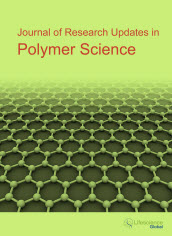jrups
Abstract : Design, Synthesis, Characterizations, and Processing of a Novel c-Donor-nc-Bridge-cf-Acceptor Type Block Copolymer for Optoelecronic Applications
|
|
Abstract: A novel c-D-nc-B-cf-A (or DBfA) type of block copolymer has been designed, synthesized, characterized, and preliminarily studied for optoectronic applications, where c-D is a conjugated donor type polyphenylenevinylene (PPV) block, nc-B is a non-conjugated bridge unit, and cf-A is a conjugated and fluorinated acceptor type PPV block. The frontier HOMO/LUMO orbital levels of D and fA conjugated blocks are -5.22/-3.06 and -6.10/-3.43 as determined from electrochemical and optical measurements. Photoluminescence emissions of D and fA are quenched in DBfA indicating a potential photo induced charge separation pathway between the donor and the acceptor blocks. Solid state thin film studies revealed more uniform and nano-scale phase separated morphologies in DBfA as compared to D/fA blend. A two orders of magnitude enhancement of photoelectric energy conversion efficiency was observed in a best solar cell fabricated from the DBfA block copolymer as compared to a best cell fabricated from the corresponding D/fA blend. Such significant photoelectric conversion enhancement could be attributed to the improvements of phase separated and bicontinously ordered nanostructure (BONS) morphology in DBfA as compared to D/fA. Keywords: Conjugated block copolymers, polyphenylenevinylenes, fluorinated conjugated polymers, donor-bridge-acceptor, electron transfer, photo induced charge separation, ligtht harvesting, optoelectronics, solar energy conversions, self-assembly, nano phase separation.Download Full Article |
Abstract : Hybrid Porphyrin-Polymeric Materials and their Amazing Applications: A Review
|
|
Abstract: Porphyrins are versatile multifunctional biomimetic molecules that are obtained by condensation of pyrrole with the desired aromatic aldehydes. The porphyrin structure can be synthetically modified by either introduction of various peripheral functional groups or metals in its core, allowing creation of various porphyrin derivatives that exhibit amazing optoelectronic properties. This feature makes porphyrins molecules extremely useful especially in hybrid combination with photonic, electronic and magnetic compounds. This review is focused on the more recently obtained porphyrin-polymeric materials and on their various analytical, industrial and medical applications. The study underlines the assembling capacity of these porphyrin-polymer hybrids to form supramolecular tunable architectures by means of the association of more building block units. Porphyrin-polymer nano- and micro-materials play a preeminent role in sensing applications involving chromophores in the formulation of organic solar cells - due to their capacity to generate photo induced charge separation centers - and as new materials with interesting catalytic properties. Besides these technical applications, the photobactericidal activity of these porphyrin–polymer materials was evaluated against Gram positive and Gram negative strains bacteria and they represent an alternative to antibiotics in order to overcome the growing bacterial multiresistance. Polymer functionalization with porphyrin is commonly used to overcome some drawbacks such as self-quenching and photo-toxicity to the skin produced by the bare porphyrins, when used as photosensitizers in the non-invasive Photodynamic therapy of cancer (PDT). Keywords: Porphyrin-polymer hybrids, aggregates, sensors, catalysts, medical applications.Download Full Article |
Abstract : An Overview of Mechanical Tests for Polymeric Biomaterial Scaffolds Used in Tissue Engineering
|
|
Abstract: Mechanical characterization of polymeric biomaterial scaffolds is essential to allow biomaterials that interface with tissues and tissue engineered constructs to be developed with appropriate mechanical strength. However, the fragility of these materials makes their mechanical characterization in a quantitative manner highly challenging. Here we report an overview of testing techniques for the characterization of mechanical properties of films, membranes, hydrogels and fibers commonly used as scaffolds in tissue engineering applications. Keywords: Optoelectronic, Ferroelectric, Piezeoelectric, Superparamagnetic, Nanocomposites.Download Full Article |
Abstract : Stabilization of Polypropylene for Rotational Molding Applications
|
|
Abstract: Rotational molding (RM) is a useful process for making large hollow objects. Due to its relatively high toughness and forgiving thermal oxidative degradation behavior, polyethylene is a most widely used material. However, it has too low elastic modulus for some important applications which leads to adaptation of polypropylene (PP) as a RM material. PP requires specially tailored antioxidant (AO) packages if it is to have any chance of surviving the often long (up to ca. 30 minutes) cycle times associated with RM. During the study the addition of the following stabilizers and antioxidants (AO) to the PP copolymer were investigated: a hindered phenolic primary AO, a phosphite secondary AO, a thioester secondary AO and a hindered amine light stabilizer. Synergistic effects between the primary and secondary AOs, as well as optimum heating times, were investigated. During the investigation formulations were prepared by compression molding and bench-scale RM. The combination resulting in the most effective synergism is the hindered phenolic primary antioxidant combined with the phosphite secondary antioxidant. A gel silica controlled release agent for the stabilizers was also investigated but did not yield significant improvements in stabilization. Keywords: Polyolefins, Rotational Molding, Antioxidants, Thermal Oxidation.Download Full Article |






















